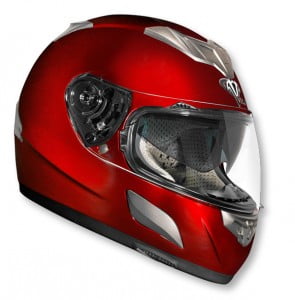So you’ve come to that place where you are ready to purchase a motorcycle helmet!
First let me say, even if you are in a location where helmets are not required by law, it’s still a good decision to wear one. Do we really need accident statistics to tell us that if we go flying off our bike, at ANY speed, and hit our head on anything, we are better off if we are wearing protection?
Not to mention, personally I think they can be very cool. And as with our motorcycles, we can make them our own with our personal style!
Having said that, how do you go about choosing a helmet?
First you need to decide what type of helmet to buy. There are basically three types that are categorized by how much of your head and face they cover.
- The full-faced helmet: Just as the name implies, this helmet completely envelops your head. Watch motorcycle racing, you’ll see one of these every time.
- The open face or ¾ helmet: This one covers almost as much as the previous, with the exception of your face, notably your chin. These helmets were made popular in the sixties and seventies. Think football helmet… but not!
- Half Helmet: This helmet covers half your head, much like a cap. They offer the least amount of protection, but the greatest amount of wind in your face. This is what you’ll see in TV shows like “Sons of Anarchy”.
Personally I have worn them all at one time or another. Riding a motorcycle has its inherent risks anyway, so which helmet you decide to go with really is a question of personal choice. Just make sure it is a good helmet that adheres to safety standards.
 That brings us to our next topic, safety standards, or helmet ratings.
That brings us to our next topic, safety standards, or helmet ratings.
DOT and Snell
Helmets are made from all kinds of materials that have been tried and tested. Some of the materials and constructions are better than others; however it’s almost impossible to tell if a helmet is a good one just by looking at it.
That’s where the safety standard like DOT and Snell come in. There are more standards than these, but for the US market they are the two best-known ones.
Let’s start with the Department of Transportation or DOT standard. This is by far the most widely available one. In most states this is the minimum standard that needs to be met in order for the helmet to be legal. You can tell a DOT helmet by the black and white DOT sticker on the back. The DOT works on an honor system, the manufacturer self-certifies that the helmet meets the relevant standards.
The Snell safety helmet standards are recognized not only in the US, but also worldwide. This is a stricter standard than the DOT, and you will find it on better quality and often more pricey helmets. In order to get Snell certified manufacturers submit samples to Snell for testing – if they pass they get the certification.
And that brings us to the big question, cost.
How much should I spend? Well, how much is your head worth to you? Helmet safety ratings and reviews are your best bet. Most helmets have video reviews posted on YouTube. It is easy to dismiss some of the higher-end helmets as just trying to get you to pay for a brand name, however there is a reason why some helmets are more expensive and that goes beyond name recognition. More expensive helmets tend to adhere to a higher standard, have a better fit and are more aerodynamic for riding.
Other than your motorcycle, your helmet is probably the most important investment you will make. So when purchasing, take your time, ask around and find the helmet that best meets your style and budget.
In my next blog I will talk about the rest of our riding gear.
Until then, remember, ride safe, ride smart, and have fun!
David Ianetta was born and raised in Boston, MA. After moving around in his younger years, he now lives in North Carolina. David has a passion for riding motorcycles,often exploring the scenic back roads of NC with is wife, Rika, who rides her own along side him.
David also writes a Daily Blog for Freedom Biker Church called, “Daily Rock“ located at www.freedombikerchurch.com and is a contributing writer for Southeastern Rider magazine.

